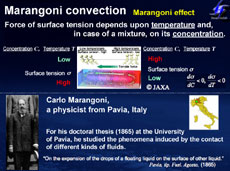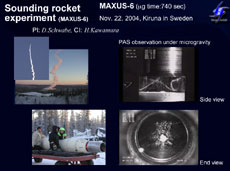
I am engaged in research on fluid dynamics under the microgravity. One of my research objectives is to develop new/useful materials with a better quality. Examples of those materials are semiconductors used for various types of electronic devices such as cellular phones and computers. To produce semiconductors, their raw materials are first melted, and then the melt crystallizes as it is cooled down. Through the study on the melt flow during the process, it is possible to develop new/useful materials with a better quality.
On the ground, the gravity causes buoyancy, and buoyancy generates convection. Convection influences the process of crystallization. So for a long time it had been presumed that, in the space, where there exists no effect of the gravity, defect-free crystals would form without being influenced by convection. Crystallization experiments in space, however, have shown an unexpected result. We now know that a different type of convection, which is not originated from the buoyancy, emerges in space, and influences the crystal growth.

Fluids have surface tension, which is resulted from the cohesive force that acts to minimize the surface area. To illustrate, it's like a group of monkeys in a cold environment clinging to each other into a smaller circle as possible to minimize their heat loss. The surface tension exerts a similar effect so as to minimize the surface area of the fluids. The surface tension is dependent on temperature and, in case of a mixture, on its concentration, too. Accordingly, if the temperature and/or concentration distribution exist over a surface, distribution of the surface tension also arises. Then, flow occurs towards a direction where the surface tension is higher. It is like a tug game, where people are pulled towards a team with the stronger force. This mechanism is called Marangoni convection, after an Italian physicist who lived in the 19th century (Figure 1). In our experiments on the Japanese Experiment Module Kibo, we are going to examine how the Marangoni convection is generated and starts to oscillate with increasing temperature difference, because the oscillatory flow causes significant influence upon the crystallization.
The outcomes the experiment will contribute not only to new material development, but also to micro/nano and to heat-transport technologies. The surface tension has a great impact in the micro-world because the gravity becomes less significant with decreasing scale. Thus the research on the Marangoni convection with a larger scale under the microgravity promises to advance micro-fluid technology on the ground. In addition, by good use of the Marangoni effect, we can develop more efficient heat transport both on the ground and in space. Examples are heat pipes for computer or satellites and also fuel cells for modern car technology.
This experimental topic for Kibo was first approved in 1993, and will be carried out after Kibo is completed next year, which means it will have been about 15 years since we submitted the original proposals. In the meantime, I have not just been waiting and doing nothing. I've been always tried to do everything we can on the ground before starting our experiments in the space. In fact, we have already made various discoveries. For example, in a joint microgravity experiment with European scientists, using a sounding rocket MAXUS-6, we verified the occurrence of Particle Accumulation Structures (PAS) in space (Figure 2), generated by Marangoni convection. The rocket, however, allows us to carry out an experiment only for a couple of conditions due to its limited flight time. As a result, we were not able to closely study the conditions that generate the phenomenon. So I am very much looking forwards to conducting our experiments in a gravity-free environment for a much longer experimental period. Also, recent advances in computers have enabled us to do more detailed analysis so that we can go to the space with a better understanding of the phenomena.
The last fifteen years of my research have been supported by my collaborators, my students, and the manufacturers who have developed the devices. Our strong curiosity about the flow phenomena in space has also pushed my team thus far. I'm looking forward to getting fruitful results by collaborating with the astronauts who will be performing the experiments for us.

On the ground, the gravity causes buoyancy, and buoyancy generates convection. Convection influences the process of crystallization. So for a long time it had been presumed that, in the space, where there exists no effect of the gravity, defect-free crystals would form without being influenced by convection. Crystallization experiments in space, however, have shown an unexpected result. We now know that a different type of convection, which is not originated from the buoyancy, emerges in space, and influences the crystal growth.
Fluids have surface tension, which is resulted from the cohesive force that acts to minimize the surface area. To illustrate, it's like a group of monkeys in a cold environment clinging to each other into a smaller circle as possible to minimize their heat loss. The surface tension exerts a similar effect so as to minimize the surface area of the fluids. The surface tension is dependent on temperature and, in case of a mixture, on its concentration, too. Accordingly, if the temperature and/or concentration distribution exist over a surface, distribution of the surface tension also arises. Then, flow occurs towards a direction where the surface tension is higher. It is like a tug game, where people are pulled towards a team with the stronger force. This mechanism is called Marangoni convection, after an Italian physicist who lived in the 19th century (Figure 1). In our experiments on the Japanese Experiment Module Kibo, we are going to examine how the Marangoni convection is generated and starts to oscillate with increasing temperature difference, because the oscillatory flow causes significant influence upon the crystallization.
The outcomes the experiment will contribute not only to new material development, but also to micro/nano and to heat-transport technologies. The surface tension has a great impact in the micro-world because the gravity becomes less significant with decreasing scale. Thus the research on the Marangoni convection with a larger scale under the microgravity promises to advance micro-fluid technology on the ground. In addition, by good use of the Marangoni effect, we can develop more efficient heat transport both on the ground and in space. Examples are heat pipes for computer or satellites and also fuel cells for modern car technology.
This experimental topic for Kibo was first approved in 1993, and will be carried out after Kibo is completed next year, which means it will have been about 15 years since we submitted the original proposals. In the meantime, I have not just been waiting and doing nothing. I've been always tried to do everything we can on the ground before starting our experiments in the space. In fact, we have already made various discoveries. For example, in a joint microgravity experiment with European scientists, using a sounding rocket MAXUS-6, we verified the occurrence of Particle Accumulation Structures (PAS) in space (Figure 2), generated by Marangoni convection. The rocket, however, allows us to carry out an experiment only for a couple of conditions due to its limited flight time. As a result, we were not able to closely study the conditions that generate the phenomenon. So I am very much looking forwards to conducting our experiments in a gravity-free environment for a much longer experimental period. Also, recent advances in computers have enabled us to do more detailed analysis so that we can go to the space with a better understanding of the phenomena.
The last fifteen years of my research have been supported by my collaborators, my students, and the manufacturers who have developed the devices. Our strong curiosity about the flow phenomena in space has also pushed my team thus far. I'm looking forward to getting fruitful results by collaborating with the astronauts who will be performing the experiments for us.
Dr. Hiroshi Kawamura
Professor, Faculty of Science and Technology, Tokyo University of Science
In 1970, after receiving his doctoral degree from the School of Engineering at the University of Tokyo, Dr. Kawamura joined the Japan Atomic Energy Research Institute as a researcher. He has been in his current position since 1988. He is also the director of the university library, and the director of the Research Center for Holistic Computational Science.
Professor, Faculty of Science and Technology, Tokyo University of Science
In 1970, after receiving his doctoral degree from the School of Engineering at the University of Tokyo, Dr. Kawamura joined the Japan Atomic Energy Research Institute as a researcher. He has been in his current position since 1988. He is also the director of the university library, and the director of the Research Center for Holistic Computational Science.

